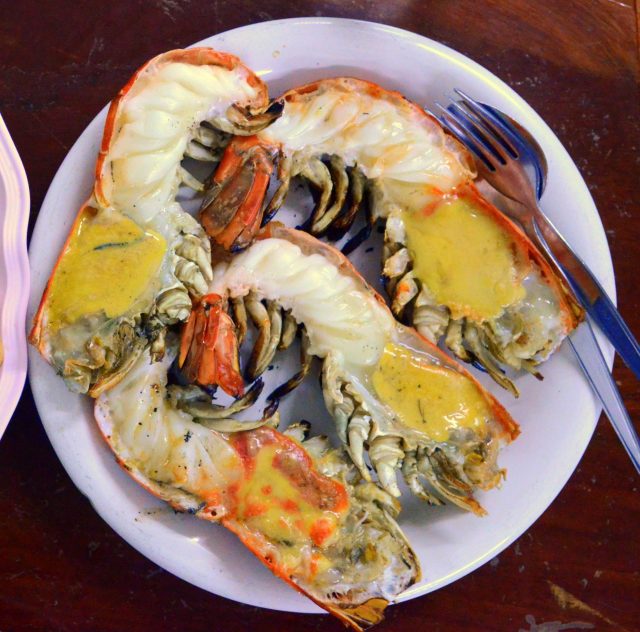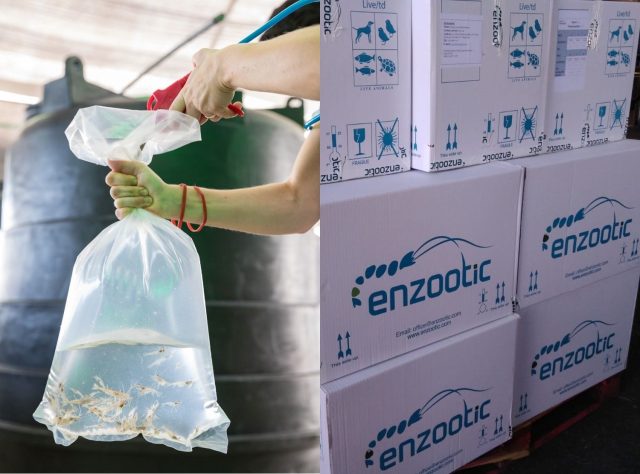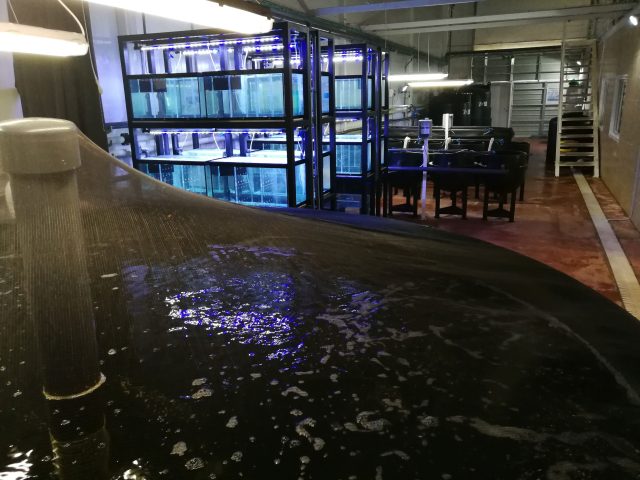
Can a shrimp smile? It's tough to say whether the gangly, blue-legged crustaceans lurking within the massive aquaculture tanks are actually happy, but they certainly appear to be content. Perhaps it's because they are well-fed and blissfully unaware of what lies just outside the laboratory: the harsh, dry environment of Israel's Negev Desert, which is not a natural habitat for any form of aquatic life. It may also be because the tank contains an all-female population, devoid of males, which tend to be territorial, aggressive, and create stressful conditions that don't promote optimal growth.
Regardless of their state of mind, these placid crustaceans are the products of a unique gender-bending technique that promises to make them a delicious link toward a sustainable global food chain. Or, the technique could be the latest in a long line of developments that force us to take a careful look at the benefits and costs of achieving sustainability by intruding into the basic biology of the food we end up eating.
Gender-bending giants
In truth, the creatures in question are not shrimp; rather, they're a species of freshwater prawns, known to biologists as Macrobrachium rosenbergii. Commonly known as giant river prawns, they are a beloved staple of traditional Southeast Asian cuisine. Their flavor and amenability to simple aquaculture techniques made them a traditional cash crop for Thai, Malaysian, and Vietnamese farmers, who raise them in large outdoor ponds.
Despite their ability to quickly and efficiently convert feedstock into body mass, their adoption in other regions has been hampered by the jungle-bred prawns' narrow comfort zone. Because they don't do well in waters cooler than 26ºC (79ºF) or warmer than 30ºC (86ºF), attempts to cultivate them in most other regions have not gone well. The critters also need relatively spacious quarters to reduce growth-inhibiting interactions with aggressive territorial males, a requirement that makes raising them in the warm but more restricted confines of high-tech aquaculture systems less cost-effective.

Now, however, freshwater prawns may be able to enjoy wider commercial success, thanks to a new breeding technique developed by Enzootic, an Israeli agro-biotech venture founded in 2012 by Dr. Assaf Shechter and Professor Amir Sagi. One of the company's first initiatives was to develop and commercialize a technology for manipulating the gender of freshwater prawns in collaboration with Israel’s Ben-Gurion University of the Negev. This collaboration led to the creation of a one-time, non-chemical, non-genetic gender-bending treatment that allows freshwater hatcheries to produce crops of all-female prawns.
Breaking a different gender barrier
Single-sex populations may seem boring to us, but for the aquaculturist, they offer several advantages. For example, all-female freshwater prawn populations are very uniform in size and less aggressive, making it feasible to raise them in the more densely packed environments needed to make indoor aquaculture profitable. Shechter says that this and several other developments make it possible to raise freshwater prawns in highly productive commercial aquaculture systems that are far less polluting and require less space, energy, and water than today's operations. (All-male populations offer other advantages that improve productivity and profits in other types of production systems.)
While it is possible to hand-sort prawns for gender, the process is time-consuming and can only be done so far down the production cycle that it's not really practical. Enzootic's gender-bending process solves that problem by going upstream to the breeding process and making alterations in breeding females that cause them to produce broods of single-sex all-female offspring.
The prawns used in this process determine their sex in a manner somewhat analogous to how it works in humans: there’s a chromosomal signal (think X/Y chromosomes) that is interpreted by an organ that makes hormones that control male and female development. But, unlike in humans, the mother can also influence the sexual development of the next generation.
Enzootics' process takes advantage of these features. It starts by surgically extracting the hormone-producing organ from "donor" males, which are then broken down into individual cells. When the cells are injected into young females, the hormones they produce cause the females to develop as males, despite their chromosomes. Just like natural male prawns, they can mate normally with other females, but some of their offspring possess a unique trait. Known as “super females,” they produce offspring that will develop as females regardless of the chromosomes they carry.
Enzootic has set up the genetics of its shrimp so that these super females are relatively easy to identify, and they can be used to quickly produce large populations of nothing but females. "Our goal was to take advantage of this natural and remarkable sexual plasticity to accomplish production of all-female populations without any kind of genetic modifications," says Shechter, Enzootic's co-founder.

Amir Sagi at Ben Gurion University of the Negev used many of the same insights on the factors that control sex differentiation of prawns enabled to develop a parallel technology for creating breeder prawns capable of producing only male offspring, a process that dramatically boosts the productivity of outdoor aquaculture operations. While all-female prawn populations are less aggressive and do better in the cramped confines of indoor tanks, males offer big advantages for operators using more spacious outdoor ponds.
The absence of females in outdoor ponds eliminates competition between males for mates that would normally result in injuries, deaths, and slower growth rates. Taking away the stimulus for aggressive behavior also reduces stress, allowing the prawns to direct even more of the calories they receive into growth. This can improve production by as much as 45 percent which, when combined with the Asian market's strong preference for the large prawns, could mean a 50- to 60-percent bump in a prawn farmer's income.
Both processes leave the prawns' natural genetic material untouched. In principle, this could avoid any potential real or imagined concerns about introducing "franken-prawns" into the food chain. The process, however, does involve some significant manipulation of the prawns’ biology, so the product might not be viewed as “natural” by people concerned about how their food is produced.
Beyond the consumer applications, Professor Sagi has also been involved in research on using the prawns to combat schistosomiasis, a debilitating waterborne disease that affects around 200 million people worldwide, primarily in impoverished areas. Also known as Snail Fever, the disease is caused by parasitic flatworms called schistosomes, which use aquatic snails as an intermediate host. Anyone swimming in, or drinking water inhabited by, these snails is likely to contract the disease, which can eventually lead to liver damage, kidney failure, infertility, or bladder cancer. In children, it may also inhibit growth and mental development.
Since the prawns are voracious predators of water snails, trials are underway to determine how commercial aquaculture operations can be most effectively configured for a parallel role as snail control centers. In a recent paper, Sagi and other proponents argue that the prawns could significantly reduce the number of infected people and the cost of the drugs required to treat them, plus the prawn ponds would provide permanent sources of food and income.

Making aquaculture sustainable
Sagi and Shechter say that giving aquaculturists a reliable way to produce crops of single-sex prawns will improve the efficiency and profitability for both traditional (extensive) and high-tech (intensive) operations. For example, Shechter cites several large-scale field studies that provide objective data that documents that all-female freshwater prawns thrive in higher stocking densities while demonstrating up to a 20-percent improvement in their Feed Conversion Ratios (FCR) when compared to a mixed-sex population. Since an all-female population can thrive in much higher population densities, operators are able to achieve far more production when limited space is available, as is the case for indoor intensive aquaculture settings.
They are also hopeful that their freshwater cultivation techniques will provide an alternative for prawn and shrimp farmers seeking to reduce the environmental impact of pond- and ocean-based crustacean aquaculture operations. For example, the cultivation of saltwater shrimp has drawn strong criticism because many production facilities in Asia and Southeast Asia are created by destroying vast stands of mangrove swamps, which are vital parts of the marine ecosystem.
Until recently, a combination of environmental, technical, and economic issues—along with the huge amounts of water required for a conventional outdoor freshwater farming operation—made North America a challenging place for aquaculturists to do business. This is changing, as the industry has begun to move away from open ponds farming and toward indoor operations based on recirculated aquaculture systems (RAS) that reuse most of their water.
Any aquaculture operation requires some amount of water exchange to keep the system healthy, but the small amount of the freshwater discharged from a prawn farm each day can be used to irrigate crops. That’s a serious bonus in sun-rich but water-starved areas such as Israel's Negev, as well as many parts of Africa and America's Southwest. Enzootic is wagering that these types of intensive indoor systems are the future of fish, shrimp, and prawn production and that the higher stocking densities made possible by their all-female breeding technology will help accelerate their adoption. In addition to their superprawns, they have developed their own indoor freshwater RAS breeding technology specifically optimized around M. rosenbergii's biological needs as a river organism.
To prove their point, Enzootic is building an indoor aquaculture facility located near Beersheba, the Negev's largest city. The demonstration farm's recirculating system only needs to exchange one percent of its tanks' capacity to keep the water and micro-ecosystem clean, balanced, and free of toxins. What's more, the exchange water, pulled from the tanks and bio-filtration system, is rich in natural fertilizers that can be used to irrigate and feed conventional or hydroponic food crops. "Since these are indoor farms, we have much better control over the water quality, and we have no need to use antibiotics, chemicals, or fertilizers" says Shechter.

Shechter claims that the advantages of indoor farming are already changing the global aquaculture industry and creating new opportunities in developed economies, such as North America. While he declined to discuss any American-based river prawn farming operations that Enzootics may have in the works, he said that the successful economics of using RAS-based indoor saltwater aquaculture systems for shrimp production are equally applicable to freshwater prawn farming.
One of the first commercially viable "farm to fork" indoor saltwater aquaculture operations in North America was Canadian Shrimp, run by Paul Cocchio and his son Brad. Based in Campbellford, Ontario, these self-taught aquaculturists (and former hog farmers) have been producing top-grade, antibiotic-free Pacific White Shrimp for consumers and many of Ontario's finest restaurants for nearly a decade. Once the Coccios had proven the economics of far-North aquaculture, others have entered the field, including Planet Shrimp Company, located in Aylmer, Ontario, which boasts a 65,000-square-foot production facility and plans for aggressive expansion.
Farther south, there's Dallas, Texas-based NaturalShrimp which has developed its own RAS technology to produce sushi-grade Pacific White Shrimp at prices that will be competitive with offshore suppliers. After nearly a decade of development, the company is initiating weekly production from its renovated pilot plant and starting construction of a second, larger production facility in La Coste, Texas.
Enzootics is betting that the use of indoor intensive freshwater farms will enable year-round local production of a traceable freshwater prawn product, one that is farmed in accordance with local food standards in a more ethical and sustainable way. Shechter says this technique would allow the company to “target countries like the USA, that cannot effectively use the traditional outdoor practices of mixed-sex to locally produce this delicious product year-round. Although the United States is a huge consumer of frozen shrimp imported from South America and Asia, there is still very little supply of locally farmed or even frozen freshwater prawns," he continues. "Using our intensive indoor all-female technology, US farmers could now grow them locally in larger quantities and controlled quality.”
Based on the information provided by Enzootic and other sources for this story, it's even possible that some of the added costs of operating in a nation with higher labor costs and tighter environmental regulations will be offset by transportation costs that are significantly lower than flying in similar products from Asia. And who knows, perhaps it could even kick-start a "tank-to-table" movement among restaurateurs.
Not green yet
Despite all these advances, several large challenges must still be overcome before freshwater prawns or any of their cousins can be considered truly green. The most glaring issue is that the pellets most prawn wranglers use to feed their aquatic herds include significant amounts of fish meal and fish oil, which is derived from harvesting vast amounts of wild fish that are not otherwise commercially viable. This new technology will certainly improve Giant River prawns' already-respectable Fish In/Fish Out (FIFO) ratio (they require less than half a unit of fish-based feed to produce a unit of commercial prawn), but the rate at which so-called "trash fish" are being harvested from the ocean is generally thought to be unsustainable.
Enzootics says that it is closely following research being done on replacements for fish-based feed, including soy beans, insects, seaweed, and even wood pulp, which may eventually enable us to enjoy truly guilt-free prawns. Until then, the best we can hope for is “more sustainable.”
But even that incremental progress toward sustainability will depend on the public’s acceptance of the relatively aggressive interventions in the prawns’ normal life cycle required to produce mono-sex populations. Enzootics, its partners, and customers are all counting on the public's widespread aversion to genetic manipulation (GMOs) not extending to the non-genetic gender manipulations they use to produce their breeding stock. But, as consumers' perception of organic foods has repeatedly shown, their unease or acceptance won't necessarily be driven by the technical details of how "pure" or "natural" are defined, and those feelings may instead be driven more by their existing beliefs and subjective perceptions. For example, a survey by the International Food Information Council Foundation conducted in 2018 found that 47 percent of consumers avoid GMO food either somewhat or completely, and other surveys hint at even higher resistance.
It's difficult to say how large a portion of the public’s concerns about GMOs will carry over to gender manipulation, but, if that happens, it may prove to be as big a barrier to sustainable aquaculture as the issues surrounding water use and feedstocks.
Lee Goldberg is a Sci-Tech journalist who has spent 25 years writing love letters to engineers, tech enthusiasts, Makers, Burners, and dreamers. A self-described "recovering electrical engineer" who worked on integrated circuits, embedded systems, and the occasional interplanetary spacecraft in his former career, Lee specializes in exploring the issues that emerge from the messy intersection where technology, society, the environment, and the economy meet. Lee, his wife, and their half-Klingon daughter live on the outskirts of Princeton, New Jersey, where they masquerade as a typical suburban family. He has previously written for Ars Technica about modern online employment scams.
Note: Lee has no relation to the talented television writer by the same name who was responsible for some of the best episodes of Monk and Murder She Wrote, but he wishes he was.
"feed" - Google News
May 10, 2020 at 09:00PM
https://ift.tt/3dwreZb
Can gender-bending Israeli superprawns help feed the world? - Ars Technica
"feed" - Google News
https://ift.tt/2z3xEQN
https://ift.tt/2yko4c8
Bagikan Berita Ini














0 Response to "Can gender-bending Israeli superprawns help feed the world? - Ars Technica"
Post a Comment